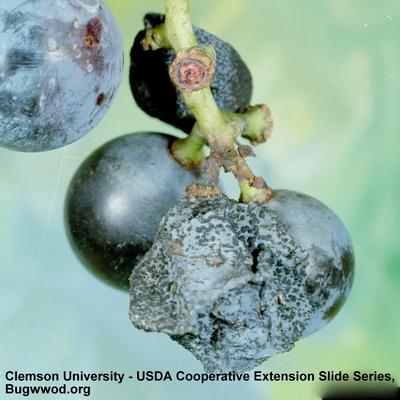Bitter Rot of Grape
Greenaria uvicola
Fungus
In a Nutshell
- Dark lesions on mature fruit.
- Irregularly sized sooty black fruits.
- Bitter and moldy taste.
Can also be found in
Symptoms
The most obvious symptoms are seen on berries. The initial symptom exists as a brownish, water soaked lesion, seen on maturing fruit. The fruits become susceptible to infection at the onset of ripening. Once the fruits are infected, they soften and small fungal fruiting structures form in concentric rings on the surface. The lesion spreads quickly in concentric rings and the entire fruit is usually affected within a short period of time. When light colored fruits are infected, they turn brown. After 2 to 3 days, the skin of the berry ruptured by black pustules. Under moist conditions, the pustules coalesce to form irregular blisters over the surface of the fruit. The skin of the fruit can become torn, and the fruit can shrivel in to black mummies closely resembling those of black rot, Phyllosticta ampelicida. Symptoms also develop on young shoots and stems of fruit clusters, but are less obvious. On infected leaves, the symptoms appear as tiny, sunken, reddish-brown flecks with yellow halos. The spores can also infect shoots, petioles and pedicels. When pedicels are infected the fungus may become inactive until the fruit matures.
Recommendations

Organic Control
Organic or reduced risk compounds such as oils, phosphorus acid, potassium bi-carbonate, potassium monophosphate, oxidate, compost tea, among others can be used to help reduce the incidence of bitter rot.

Chemical Control
Always consider an integrated approach with preventive measures together with biological treatments if available. Protect fruit during warm season with fungicides from bloom to harvest, especially susceptible cultivars. The disease can be controlled in the early to mid- summer by fungicide sprays targeted against other diseases such as downy mildew and black rot. For effective control in the field and storage, apply sprays of iprodion 75 WG (0.2%), bitertanol 25 WP (0.1%) and thiophanate methyl (0.1%) .
What caused it?
Damage is caused by the fungus Greeneria uvicola, which overwinters in the vineyard, on almost any plant debris especially berry mummies. The fungus tissue growing on plant litter produce spores. Weather conditions such as warm, humid and rainy conditions favor fungus growth and spore formation. Symptoms are noticed on berries one week after spores come in contact with a healthy berry, and in less time if the berry is wounded. They are usually active in low temperatures. Spores present on fruit can be rain splashed to other fruits and can cause subsequent infections. Bitter rot is often confused with black rot; however, the fungus that causes black rot infects immature fruits while the fungus that causes bitter rot infects mature fruits only.
Preventive Measures
- Use resistant cultivars or late maturing cultivars, where available.
- Control weeds and suckers to promote good air circulation and light penetration.
- Practice proper pruning and positioning or removing of shoots for uniform leaf development.
- Plant rows in the direction of prevailing wind , where possible.
- Insects, birds and other grape diseases should be controlled to prevent wounding of berries.
- Practice good sanitation in your vineyard.
- Remove mummified grapes from the vines.
- Remove and destroy the plant debris to help limit the fungal damage.
- Prune and destroy old canes, clusters and other plant parts to significantly reduce the number of spores.
- Increase air circulation in the vineyard by removing mummies (raisin like, hard remnants of fruit) from the canopy.
- Manage the canopy during the season to increase airflow and reduce leaf wetness duration.
- Strategic leaf pruning can reduce drying time.



